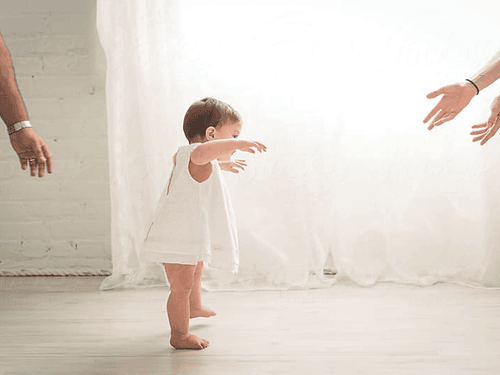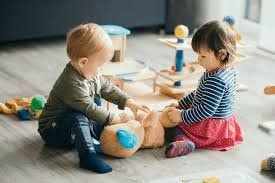This is an automatically translated article.
13-month-old babies are no longer babies with no awareness of their surroundings. They have begun their journey to discover life by listening to sounds, using words and gestures to communicate with people.1. Can a 13-month-old child talk yet?
New feature of this age group: Can they talk to their parents?Around 13 months of age, many toddlers have a vocabulary consisting of three or four simple words. Children may say "mom" or "dad," and something like "ta ta," to say thanks, "ball" for the bottle or ball, and "goodbye." But don't be upset if your child can't. Children are still in what experts call the "passive" stage of language acquisition. That means they are absorbing all the words and speeches around them and storing the information for later use. Even if your child can't say any words clearly, he or she can communicate his needs with gestures (reaching out your hand for you to pick up), sounds, and body positions, such as turning your head away from your eyes. something a child doesn't want to do or doesn't want to see.

Khoảng 13 tháng tuổi, nhiều trẻ mới biết đi có vốn từ vựng bao gồm ba hoặc bốn từ đơn giản
2. What can parents do to help their 13-month-old child develop language and cognition?
If you've noticed your child doesn't talk much, encourage them to keep trying new words by labeling as many actions and objects as possible. Use a clear, simple voice in your mother tongue - words spoken with exaggerated pitch and intonation will help your child notice your voice and memorize it faster. Using baby talk or meaningless words like "a" and "ê" interferes with language learning.Talk about where the whole family is going when the parents tie the child to the car seat. While at the grocery store, tell your child what you're looking at ("Let's go get the banana" or "Here's the milk"). Talking to your child, even if she can't fully respond, will make her feel part of what's going on around her and make her want to participate in the conversation. Singing songs, especially songs with gestures and lots of action words, also make talking fun and interesting - they also provide a great opportunity for children to be exposed to music. .
The other side of talking is listening. If you want to encourage your child to talk, listen to her when she "talks" to you the same way you would if you could understand every word perfectly. Make eye contact with your child and respond with a smile and nod, and your child will want to talk to you more and more. In addition, children learn valuable lessons about listening carefully when others are speaking.
Even if your 13-month-old can only say a few words, he can still communicate so much more. Have you ever noticed that babies younger than 13 months will wave goodbye, kiss, and nod or shake their heads to say yes or no? They are speaking with gestures they have observed others use and repeat perfectly. Recent research shows that children are capable of assigning different gestures to dozens of words - but parents have to teach them. If your child seems frustrated that he can't make you understand his needs, try making hand signs to help him. For example, you can put your thumb over your mouth to signal the word "drink". For a few days, whenever you give your child a cup, show him the gesture and say the word at the same time. Within a few days, your child may surprise you by using his own sign to ask for a drink.

Hãy giao tiếp bằng mắt với trẻ và đáp lại bằng nụ cười và cái gật đầu
3. What does a 13-month-old baby know?
Other Developments: Perception of intonation and object permanenceJust as your baby imitates you when you pet the dog or water the garden, 13-month-olds are listening intently to what you have to say and the way you say it so your baby can try too. Next time you hear your child babble, listen to what he "says". Parents will notice that their baby's intonation sounds a lot like they're talking, even though the child doesn't say any words. When you ask your child a question, she will likely respond with a series of gestures and babbles, signaling that she understands what you are asking. Parents can also observe how the child responds with a frantic "No!" when you warn your child to stay away from a hot dish or an unfamiliar animal, or talk to him in a more praise-worthy tone to get him to stop pulling your leg. If parents notice a difference in their child's reactions, it means that the child has already realized that intonation plays a role in communication.
At 13 months, babies are testing their vision and they are starting to understand that objects are permanent. In other words, children begin to realize that a toy exists even when they cannot see it. Avoiding and hiding from the shadows can no longer be the motto to hide children!
To check if your child understands the permanence of objects, roll a toy under the seat and see if the child can find the right spot. Or hide a stuffed animal under a blanket for your child to find on their own.
A word of caution: 13-month-olds are honing their problem-solving skills, doing things like trying to use objects, flipping switches, and turning kitchen knobs. Since children cannot perceive danger, make sure your home is properly designed and adequately protected for children.

Khi được 13 tháng tuổi, trẻ đang kiểm tra khả năng quan sát của mình
In addition to zinc, parents also need to supplement their children with other important vitamins and minerals such as lysine, chromium, B vitamins,... errands.
Please regularly visit Vinmec.com website and update useful information to take care of your baby and family.
Reference source: babycenter













